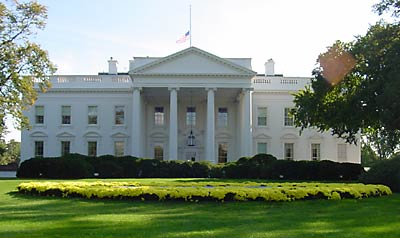Do we need a new National Space Council?by Taylor Dinerman
|
| In the absence of a “real” administrator, NASA is drifting, and the success the agency had in getting an extra billion out of the stimulus package may mask a deeper long-term problem. |
For NASA it is easy to see that the two most recent administrators represented, with some nuances, both these types, O’Keefe was the president’s man, sent in to make some reforms and to keep things on an even keel. Griffin, in spite of his management style, was closer to the organization and within the limits of the budget pushed forward the agency’s long-range agenda embodied in the Vision for Space Exploration (VSE).
In the absence of a “real” administrator, NASA is drifting, and the success the agency had in getting an extra billion out of the stimulus package may mask a deeper long-term problem. In the short term the agency is lucky to have two strong leaders: Bill Gerstenmaier at the Space Operations Directorate and Ed Weiler at Science, but that may not be enough to avoid trouble if the vacuum at the top lasts for many more months.
Will the proposed revived National Space Council hurt or help America’s exploration program and will it create the conditions for a bureaucratic and political power struggle between the agency and the administration? During his confirmation hearing earlier this month the president’s new science advisor, John Holdren, said, “We have been looking at what the best way to resurrect the National Space Council in the White House would be. I think that’s going to happen.”
The National Space Council is a relatively recent invention (see “A new space council?”, The Space Review, June 21, 2004). Previously space policy was either decided by the president and a few trusted aides, working within the context of the 1958 law that established NASA and created the National Aeronautics and Space Council, which was eliminated by Nixon. Under Reagan policy emerged from a Senior Inter-Agency Group for Space, the so-called SIG-Space.
The National Space Council was established in the final months of the Reagan administration specifically at the request of George H.W. Bush and was presided over by his vice president, Dan Quayle. Its signature product, the Space Exploration Initiative (SEI), announced by Bush on the 20th anniversary of the Apollo 11 Moon landing, failed miserably. The initial cost estimates of something like $400 billion over twenty or thirty years came out to about $13 or 14 billion 1989 dollars a year. In hindsight this may seem reasonable when one considers that NASA’s budget for that year was $11 billion, but politically it was poisonous and the numbers crippled NASA’s exploration plans for almost a decade.
At least Quayle was pushing a policy that was in line with what NASA as an institution had always wanted. He was not trying to transform it into something new. The flaws in the SEI were, for the most part, not due to the operations of the Space Council but to mistakes inside the NASA’s own public relations and congressional liaison offices as well as to strategic mistakes made by the administrator.
Quayle did much better when he supported the initial funding for the DC-X program, but that was a Defense Department program overseen by the Strategic Defense Initiative Organization (now the Missile Defense Agency). This project proved that a relatively low-cost suborbital demonstration program could produce a new way of thinking about the way we get to and from orbit.
| The last thing this new administration needs is a protracted and unnecessary fight over space policy and bureaucratic turf. A strong administrator with clear guidance, and backing from the president, is by far the best outcome. |
As a senator Quayle (and Al Gore too for that matter) had worked on military space issues and missile defense issues, and thus he understood the basics. As far as one can tell Joe Biden has no such record, either on the civil or military sides of the problem. It would be hard to imagine that he will be able to make up for a long career spent ignoring space in a few weeks, particularly given everything else on his agenda.
As Dwayne Day pointed out in 2004, “A civilian space policy organization in the White House will naturally clash with NASA over the direction of the civilian space program.” The last thing this new administration needs is a protracted and unnecessary fight over space policy and bureaucratic turf. A strong administrator with clear guidance, and backing from the president, is by far the best outcome.
A White House space council would also been seen as a locus for the politicization of NASA, and given the ongoing fights over the science of climate change, this would be a major credibility problem for both the president and for the agency. The clash between the president’s natural desire to receive confidential and private policy advice and the need for “open science, openly arrived at” (to paraphrase Woodrow Wilson) is obvious. This is a subject the new administration should think long and hard about.
